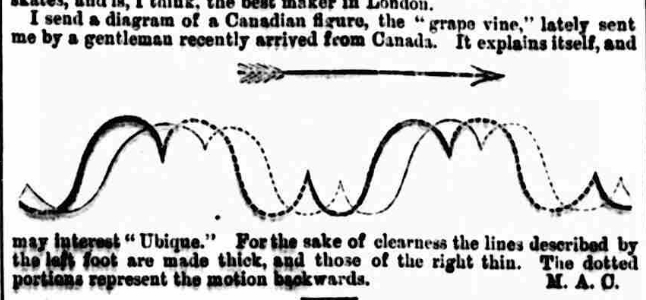
Freestyle slalom skating is interesting because it preserves some moves that have been lost in modern figure skating, like grapevines and the full range of pivots, and because it doesn’t try to be like ice skating. Instead, it takes advantage of the architecture of inline skates. It’s also still developing.
USA Roller Sports has set up a series of levels, or “grades,” in freestyle slalom skating. These parallel the tests figure skaters have worked at for over a century: passing one gives you a feeling of accomplishment and concrete evidence of your skating skill.
The slalom tests are structured like the ISI freestyle tests in figure skating: first you do each maneuver in isolation, then you skate a program (1:45-2:00 minutes) to music of your choosing that incorporates at least six of the tricks. General skating skills and transitions are considered in the program.
Here are the USARS freestyle slalom test requirements, with links to video tutorials. I’ve given preference to English-language tutorials. I am not affiliated with any of these videos or USARS. The tests are copied from the USARS site, and I found the videos by searching YouTube.
Grade I
Grade II
- Crazy
- Mabrouk
- Stroll (‘Double Crazy’)
- Back Stroll (‘Back Double Crazy’)
- Mega
- Crab
- 1-Foot
- Italian
- Mexican
- Crazy Sun
Grade III
- 8
- Back 8
- X
- Jumping X
- 1-Foot Backward
- Toe Toe Snake
- Volte (no English)
- Grande Volte
- Eagle or Eagle Cross
- Small Car (‘The Midget’)
Grade IV
- J-Turn
- Reverse J-Turn
- Brush
- Backward Brush
- Special
- Heel-Toe Back Snake
- 1-Cone Crazy
- 1-Cone Double Crazy
- 1-Cone Back Double Crazy
- Drift
Grade V
- Wiper
- Fan Volte or Total Cross
- Swan or Screw
- Toe Wheeling (4 cones)
- Heel Wheeling (4 cones)
- Crazy Legs
- One of Rekil / Reverse Rekil / Total Foot / Foot Shift
- Footgun or Touch Down (no video, please make one!)
Grade VI
- Other of Swan or Screw
- Two more of Rekil / Reverse Rekil / Total Foot / Foot Shift
- One of Wheeling Eagle / Inverted Side Surf (no video, please make one!) / Jumping Special (no video, please make one!)
- One of Back Footgun / Back Touchdown (no video, please make one!) / Kasakchok / Christie / Deck Chair
- Back Heel Wheeling or Back Toe Wheeling (4 cones)
Grade VII
- Other of Back Heel Wheeling or Back Toe Wheeling
- Sewing Machine (2 cones)
- Seven (2 cones)
- Wheeling Forward-Backward (4 fw – 4 bw)
- Cobra
- Chicken Leg (2 rotations)
- Another of Back Footgun / Back Touchdown (no video, please make one!) / Kasakchok / Christie / Deck Chair
Grade VIII
- Seven (4 cones)
- Wheeling Shift (4 cones)
- Wheeling Rekil
- Chicken Toe (2 rotations)
- Backward Cobra
- Toe Inverted Eagle or Butterfly
- One of Back Deckchair / Toe Christie / Back Christie / Back Kazakchok / Footgun Foot Spin (no video, please make one!)
There are many brief videos of tricks on the World Slalom Skaters Association YouTube Channel.




